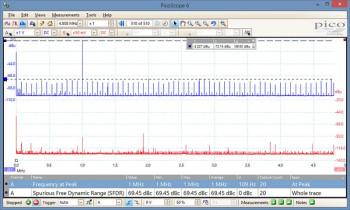12 bit oscilloscopes with optional IEPE interface

- 2 or 4 channels
- Optional IEPE interface (for accelerometers, microphones etc)
- 12 bit resolution
- 20 MHz bandwidth
- 32 MS buffer memory
- Serial decoding and mask testing as standard
- USB connected and powered
- Windows, Mac and Linux software
The Picoscope 4424 and 4224 offer both a high resolution (12 bits) and a high DC accuracy (1%) making them an excellent choice for noise, vibration, precision electronics and mechanical analysis.
The optional IEPE interface (see below) allows for the direct connection and powering of industry standard accelerometers and microphones.

High resolution offers 16x more detail
The PicoScope 4224 and 4424 are 12-bit oscilloscopes that offer 16 times more vertical resolution than traditional 8-bit oscilloscopes (4096 vertical levels vs 256). The example shows how with a 12-bit oscilloscope (blue trace) you can zoom in to reveal details of the signal that are not visible on an 8-bit oscilloscope (black trace).
As well as the high vertical resolution, the 32 million sample buffer memory ensures a high horizontal resolution as well. You can collect long detailed captures without the sampling rate dropping.
Once you have seen high-resolution waveforms on a high-resolution PC monitor you will never want to use a traditional benchtop oscilloscope with its small display again.
As well as improved oscilloscope traces, high resolution offers big benefits when performing spectrum analysis offering an additional 20 dB dynamic range on the spectrum over 8-bit oscilloscopes. Signals that were previously hidden in the noise floor are now clearly visible and the spectrum becomes a powerful tool to track down the causes of noise.

IEPE Interface
The PicoScope 4224 is available with an optional internal IEPE (integrated circuit piezoelectric) interface allowing for the direct connection and powering of industry standard accelerometers and microphones.
When disabled the channels can be used as normal oscilloscope inputs. When IEPE is enabled (each channel has independent control via software) the input is AC coupled and a 24 V, 4 mA signal is output to power external sensors.
The high resolution and dynamic range of the 4224 makes it ideal for use with accelerometers and microphones. Having the IEPE interface built in makes for a compact, portable solution.

Advanced display
PicoScope software dedicates almost all of the display area to the waveform. This ensures that the maximum amount of data is seen at once. The viewing area is much bigger and of a higher resolution than with a traditional benchtop scope.
With a large display area available, you can also create a customizable split-screen display, and view multiple channels or different views of the same signal at the same time. As the example shows, the software can even show multiple oscilloscope and spectrum analyzer traces at once. Additionally, each waveform shown works with individual zoom, pan, and filter settings for ultimate flexibility.
The PicoScope software can be controlled by mouse, touchscreen or keyboard shortcuts.

FFT spectrum analyzer
The spectrum view plots amplitude vs frequency and is ideal for finding noise, crosstalk or distortion in signals. The spectrum analyzer in PicoScope is of the Fast Fourier Transform (FFT) type which, unlike a traditional swept spectrum analyzer, can display the spectrum of a single, non-repeating waveform.
A full range of settings gives you control over the number of spectrum bands (FFT bins), window types, scaling (including log/log) and display modes (instantaneous, average, or peak-hold).
You can display multiple spectrum views alongside oscilloscope views of the same data. A comprehensive set of automatic frequency-domain measurements can be added to the display, including THD, THD+N, SNR, SINAD and IMD. A mask limit test can be applied to a spectrum for automated testing.
More information on Spectrum analyzer >>

Signal integrity
Most oscilloscopes are built down to a price. PicoScopes are built up to a specification.
Careful front-end design and shielding reduces noise, crosstalk and harmonic distortion. Years of oscilloscope design experience can be seen in improved bandwidth flatness and low distortion.
We are proud of the dynamic performance of our products and, unlike most oscilloscope manufacturers, we publish our specifications in detail. The result is simple: when you probe a circuit, you can trust in the waveform you see on the screen.

Portability
Pico Technology oscilloscopes are small, light and portable. In the lab they take up the minimum of bench space while for the engineer on the move they are small enough to fit in a bag with your laptop.
The USB connection makes printing, copying, saving, and emailing your data from the field quick and easy. The high-speed USB interface allows fast data transfer, while USB powering removes the need to carry around a bulky external power supply, making the scope even more portable for the engineer on the move.
The PicoScope 4424, 4224 and 4224 IEPE are supplied with software, documentation and USB cable. For the 4224 and 4424 a kit also containing oscilloscope probes and a carry case is available.